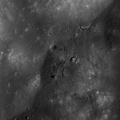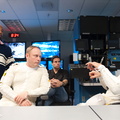
WIKIARCHIVES.SPACE
The Human Spaceflight Archive

Boulders and simple craters perched on top of Kepler crater's central peak. LROC NAC M111843702R, image width is 500 meters (1640 feet).
Information
- Taken in
- Author
- NASA/GSFC/Arizona State University
- Description
-
Boulders and simple craters perched on top of Kepler crater's central peak. LROC NAC M111843702R, image width is 500 meters (1640 feet).
Despite the label "central peak," a central peak is not always exactly in the center of a crater, nor is it always symmetrically shaped; Kepler crater is an example. Instead of having a nice central peak, Kepler crater has an irregular off-center peak. This form is most likely due to the crater being close to the boundary diameter between a simple and complex crater.
NASA's Goddard Space Flight Center built and manages the mission for the Exploration Systems Mission Directorate at NASA Headquarters in Washington. The Lunar Reconnaissance Orbiter Camera was designed to acquire data for landing site certification and to conduct polar illumination studies and global mapping. Operated by Arizona State University, LROC consists of a pair of narrow-angle cameras (NAC) and a single wide-angle camera (WAC). The mission is expected to return over 70 terabytes of image data.
- Created on
- Friday 12 November 2010
- Albums
- US SPACE PROGRAM / PROBES / MOON / LRO/LCROSS / Mission Photos (Edited)
- Source link
- https://photojournal.jpl.nasa.gov
- Visits
- 17
- Rating score
- no rate
- Rate this photo
- License
- Public Domain
- Modified by WikiArchives
- No (original)
- Downloads
- 0
Powered by Piwigo











